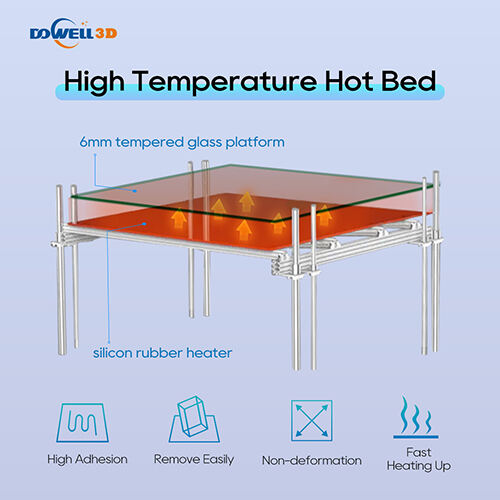ကြီးမားသော-လိုင်း 3D ပရင့်တာများ ပရင်တင်းဆက်ရှင်အတွင်း ပရိုတိုတိုင်း၊ ကိရိယာများနှင့် ပြီးပြည့်စုံသော အစိတ်အပိုင်းကြီးများကို ထုတ်လုပ်ရန် မယုံနိုင်စရာ စွမ်းအားကို ဖော်ထုတ်နိုင်စွမ်းရှိသည်။ သို့သော် ထိုကဲ့သို့ တိုင်းတာမှုမျိုးသည် အမြဲတမ်း မရပ်စဲသော ခေါင်းကိုက်စရာများကို ဖြစ်စေပြီး တည်ဆောက်မှုပြား၏ ကပ်ငြိမှုသည် အောင်မြင်မှုနှင့် အလွန်ကုန်ကျစရာများပြီး အချိန်ကုန်သက်သာရန် အဓိက အချက်အလက်တစ်ခု ဖြစ်လာတတ်သည်။ အစိတ်အပိုင်းများ သို့မဟုတ် ပရင်တ်ဘက်များ၏ အရွယ်အစားသည်ပါ ကိုယ်ပိုင်ဖြေရှင်းနည်းများ လိုအပ်သည့် ထူးခြားသော စိန်ခေါ်မှုများကို ဖြစ်စေသည်။
အရွယ်အစားကြီးလောက် ကပ်လျက်နေရာ ပြဿနာများ ပိုမိုဖြစ်ပေါ်စေပုံ-
1.အပူချိန် ဖိအားများလာခြင်း- ပို၍ကြီးမားသော ပရင့်တာများတွင် ပုံမှန်ထက် အဆတဆ ပိုမိုသော ပစ္စည်းများကို အသုံးပြုရပါသည်။ ထိုပစ္စည်းများ အေးသွားသောအခါ အတွင်းပိုင်းတွင် ဖိအားများ ဖြစ်ပေါ်လာပါသည်။ ထိုဖိအားများသည် ပလိတ်နှင့် ထိစပ်နေသော ပထမဆုံးအလွှာတွင် စုပေါင်းလာပြီး ပရင့်တာ၏ အောက်ခြေနေရာ ကျယ်သည့်အတွက် အစွန်းများကို အပေါ်သို့ ဆွဲထုတ်လာသော အားကို ဖြစ်စေပါသည်။
2.ချိန်ညှိခြင်းနှင့် ကွေးခြင်းအားသုံးခြင်း- အကြီးစားပြားပြားသည် ရှည်လျားသောချိန်ညှိကိရိယာတစ်ခုဖြစ်သည်။ ထောင့်တစ်ထောင့်မှ အနည်းငယ်ကွေးခြင်း/ပေါ်သို့မထောင်ခြင်းသည် ပုံနှိပ်မှုကို အုတ်မြစ်မှ ဖယ်ရှားရန်အတွက် အကြီးအကျယ် စက်မှုအကျိုးသက်ရောက်မှုတစ်ခုဖြစ်သည်။ သေးငယ်သောပုံနှိပ်မှုတွင် အနည်းငယ်မြှောက်ခြင်းသည် လုံလောက်နိုင်သော်လည်း ကြီးမားသောပုံနှိပ်မှုတွင် ပြင်းထန်သော ခွဲထွက်မှုသို့ ပိုမိုဖြစ်ပွားလေ့ရှိသည်။
3.မျက်နှာပြင်ဧရိယာချို့ယွင်းချက်များ- အလွန်ကြီးမားသောတည်ဆောက်မှုမျက်နှာပြင်ပေါ်တွင် ပြားပြားလျောလျောဖြစ်ခြင်းနှင့် တစ်ညီတည်းဖြစ်ခြင်းတို့ကို ရယူခြင်းသည် အမှန်အကန်ပင်ပိုမိုခက်ခဲပါသည်။ သေးငယ်သောအုတ်မြစ်တွင် စိတ်မပူရသော အမြင့်ခြားနားမှုများ၊ အုတ်ထုတ်များ သို့မဟုတ် အုတ်ချွတ်များသည် ကြီးမားသော ပထမဆုံးအလွှာကို နေရာအနှံ့အကျယ် ဖုံးလွှမ်းခြင်းအတွက် စိတ်မကောင်းဖွယ်ကောင်းသော အခြေအနေတစ်ခုဖြစ်လာပါလိမ့်မည်။ ဆီများ၊ မှုန့်များစသည်တို့သည် နေရာယူနိုင်သော မျက်နှာပြင်ဧရိယာပိုမိုရှိပါသည်။
4. အထွားပုံနှိပ်ချိန်များ - ကြီးမားသောပုံနှိပ်မှုများသည် နာရီများစွာ၊ နေ့များစွာပင် ကြာမြင့်စေပါသည်။ ဤကာလအတွင်း အပူချိန်ဖိအားများစုဆောင်းရန် အချိန်ပေးပြီး ကပ်လျက်အလွှာတွင် လုပ်ဆောင်နိုင်ပါသည်။ အခန်းအတွင်းရှိ ပတ်ဝန်းကျင်၏ သဘောသဘာဝမှာ ဥပမာအားဖြင့် လေညှင်းခြင်း သို့မဟုတ် အပူချိန်ပြောင်းလဲမှုများကဲ့သို့မှာ အချိန်ကြာလာသည်နှင့်အမျှ ပို၍ကြီးမားသော စုစုပေါင်းသက်ရောက်မှုကို ဖြစ်စေပါသည်။
5. ပစ္စည်းအပြုအမူ - ကျုံ့ခြင်းနှင့် လှိုင်းခြင်းတို့ကို တမ်းတသော ပစ္စည်းများ (ဥပမာ - ABS၊ နိုင်လွန်း၊ ပုံနှိပ်ထားသော PETG ကြီးမားသည့်ပစ္စည်းများ) သည် ပို၍ပင် ကျယ်ပြန့်သော ပမာဏတွင် ပို၍ပင်ဖြစ်ပါသည်။ ထုတ်လုပ်ထားသော အင်အားများသည် ပုံမှန်ကပ်လျက်နည်းပညာများကို လွယ်ကူစွာကျော်လွန်နိုင်ပါသည်။
ကြီးမားသောကပ်လျက်အောင်မြင်မှုအတွက် နည်းစနစ်များ-
ဤစိန်ခေါ်မှုများကို overcome လုပ်ရန် အမျိုးမျိုးသောနည်းလမ်းများကို အသုံးပြုရပါမည်-
1. ဂိုဒေါင်ပြငင်ဆင်မှုကို ဂရုတစိုက်လုပ်ဆောင်ခြင်း-
သန့်ရှင်းရေးသည် အရေးကြီးပါသည် - ပုံနှိပ်မှုကြီးမားသည့်အချိန်တိုင်းတွင် တည်ဆောက်သောမျက်နှာပြင်ကို မြင့်မားသောသန့်ရှင်းမှုရှိသော အိုင်ပီအေ (IPA >90%) သို့မဟုတ် အထူးသန့်စင်ရေးပစ္စည်းများဖြင့် သန့်ရှင်းရေးပြုလုပ်ပါ။ ရန်သူမှာ လက်ဗွေဖြစ်ပါသည်။
တိကျမှု ပြိုင်ညီစေရန် - ပုံနှိပ်ခြင်းပြင်ပြိုင်ညီမှုစနစ် (လက်နှိပ်သို့မဟုတ် အလိုအလျောက်) ကို အကောင်းဆုံးအသုံးပြုပါ။ ပုံနှိပ်ပြင်တစ်ခွင်ရှိ မညီညာမှုများကို ဖော်ထုတ်၍ အစားထိုးရန် ပြိုင်ညီမှုကို အကောင်အထည်ဖော်ပါ။ ပုံနှိပ်ပြင်ကို မကြာခဏ ထပ်မံစစ်ဆေးပါ။
မျက်နှာပြင်ရွေးချယ်ခြင်း - သင်နှစ်သက်သော ပစ္စည်းအလိုက် (ဥပမာ- PLA/PETG = အက်ကွဲ PEI၊ နိုင်လွန် = ဂရိုလိုက်စသည်) ကပ်ရှိန်းကောင်းသော မျက်နှာပြင်များကို ရွေးချယ်ပါ။ မျက်နှာပြင်ကို နူးညံ့စေပြီး အပြစ်အနာအဆာမရှိစေရန် ပြုလုပ်ပါ။
2.ပထမဆုံးလွှာဆက်စပ်ပစ္စည်းများကို အကောင်းဆုံးဖြစ်အောင်ပြုလုပ်ခြင်း-
နှေးနှေးထုတ်ဝေပါ- ပထမဆုံးလွှာကို ပို၍နှေးကွေ့စွာ (ဥပမာ- 15-30 mm/s) နှိပ်ထုတ်ပါ။ နောက်တစ်ကြိမ် ပြန်လည်ဖိအားပေးမှုမပြုမီ လိုင်းတစ်ကြောင်းစီကို တိကျစွာ ထားရှိနိုင်ရန် အချိန်ပေးပါ။
အနည်းငယ်ဖိပေးပါ- မှန်ကန်သော နှုတ်ခမ်းအမှတ် (Z-offset)။ အောက်ဆုံးလွှာကို အများဆုံးထိတွေ့နိုင်သော ဧရိယာကို ပေးစွမ်းနိုင်ရန် အနည်းငယ်ဖိပေးသင့်ပါသည်၊ သို့သော် နှုတ်ခမ်းကို ကြမ်းတမ်းစွာ မဖိပေးပါနှင့်။
အပူချိန်ကိုတိုးပါ- ပထမဆုံးလွှာနှိပ်ထုတ်စဉ်တွင် နှုတ်ခမ်းအပူချိန်နှင့် ပုံနှိပ်ပြင်အပူချိန်ကို အနည်းငယ်မြှင့်တင်ပေးပါ။ ပစ္စည်းများ၏ စီးဆင်းမှုနှင့် ချိတ်ဆက်မှုကို ပိုကောင်းမွန်စေရန်အတွက်ဖြစ်ပါသည်။
၃။ ခိုင်မာသော ပူပေါင်းစေသည့် အကူအညီများကို အသုံးပြုခြင်း-
အစွယ်များ- အချို့ကိစ္စများတွင် လွတ်လွတ်ဆွဲထားသော အစွယ် (၅-၁၅မီလီမီတာ+) လိုအပ်ပါသည်။ အစိတ်အပိုင်း၏ အစွန်းများကို ဆွဲထုတ်နေသော အကွေးကျိုးများကို ခံနိုင်ရန် ခြေထောက်နှင့် ပူပေါင်းနိုင်သော ဧရိယာကို သိမ်းဆည်းပေးသောကြောင့် အစွန်းများသည် အလွန်အမင်း ဧရိယာကို တိုးမြှင့်ပေးပါသည်။
ရေပေါ်တံတားများ- ပြင်ရန်မှာ ပို၍ပင် ခက်ခဲသော ပစ္စည်းများ သို့မဟုတ် ပုံစံများကို ပြင်ဆင်ရန် လိုအပ်ပါက ရေပေါ်တံတားသည် အကောင်းဆုံး ပူပေါင်းမှုကို ပံ့ပိုးပေးနိုင်ပြီး မော်ဒယ်ကို အပူချိတ်ဆက်မှုမှ ကာကွယ်ပေးနိုင်သော်လည်း နောက်ပိုင်းကာလအတွက် အချိန်ကို တိုးမြှင့်ပေးပြီး ပစ္စည်းများကို သုံးစွဲမှုကို တိုးမြှင့်စေပါသည်။
ကပ်ရည်များ- အမှုန်များဖြင့် ဖွဲ့စည်းထားသော အရည်အသွေးကောင်းသော ကပ်ရည်များ (ABS အမှုန်များအတွက် အထူးပြုလုပ်ထားသော၊ PVA အခြေခံကပ်ရည်များ၊ သို့မဟုတ် ၃D ပုံနှိပ်မှုအတွက် အထူးဒီဇိုင်းထုတ်ထားသော ဆံပင်ဖျန်းဆေး) သည် ဧရိယာကျယ်ကျယ်တွင် အလွန်ကောင်းမွန်စွာ အလုပ်လုပ်နိုင်ပါသည်။ တစ်ပြေးညီ နှင့် ပါးလွှာစွာ လုပ်ဆောင်ပါ။
၄။ ပတ်ဝန်းကျင်ထိန်းချုပ်မှု-
အဝင်အထုပ်များ- ABS သို့မဟုတ် နိုင်လွန်းတွင် ဤပုံနှိပ်ထုတ်လုပ်မှုများအတွက် အလွန်ကြီးမားသော အဝင်အထုပ်ကို ပေးပို့ပါ၊ အဝင်အထုပ်ကို အသုံးပြုခြင်းသည် ပုံနှိပ်ထုတ်လုပ်မှု၏ ဘက်ပေါင်းစုံတွင် တည်ငြိမ်သော အပူချိန်ကို ထိန်းသိမ်းပေးသောကြောင့် အေးခြင်းနှုန်းနှင့် အပူချိန်ကွာခြားမှုကို လျော့နည်းစေပြီး ပုံနှိပ်ထုတ်လုပ်မှုများကို အကျိုးသက်ရောက်မှုကို လျော့နည်းစေပါသည်။ ပုံနှိပ်ထုတ်လုပ်စဉ်အတွင်း အဝင်အထုပ်၏ အပေါက်များကို အနည်းငယ်သာဖွင့်ပါ။
လေတိုက်ခတ်မှုများ- ပရင်တာကို လေအေးပေးစက်များ၊ လေပိုက်များ၊ ပွင့်လျက်ရှိသော မျက်နှာပြင်များ သို့မဟုတ် လေတိုက်ခတ်မှုကို ဖြစ်စေနိုင်သော တံခါးများတွင် မထားပါနှင့်။
5. မော်ဒယ်ဒီဇိုင်းစဉ်းစားရမည့်အချက်များ-
ထက်မြက်သောထောင့်များကိုရှောင်ပါ- ကြီးမားသော ပြားချပ်သည့် မျက်နှာပြင်များတွင် ထက်မြက်သော ထောင့်များသည် မျက်နှာပြင်ကို ကွေးခြင်းဖြစ်စေသော နေရာများဖြစ်ပါသည်။ မော်ဒယ်၏ အောက်ခြေတွင် ထောင့်များကို ခွဲခြားခြင်း သို့မဟုတ် ဖိလဲများထည့်ခြင်းသည် မော်ဒယ်တွင် ဖိအားများကို ပြန့်ပေးရာတွင် ကူညီပေးပါလိမ့်မည်။
အနေအထား- ဖြစ်နိုင်ပါက အစိတ်အပိုင်းကို အောက်ခြေသို့ မကပ်လျက် ကြီးမားသော ပြားချပ်သည့် မျက်နှာပြင်များကို တိုက်ရိုက်ထိတွေ့ခြင်းမှ ရှောင်ရှားရန် အနေအထားကို ပြောင်းလဲပါ။ တစ်ခါတစ်ရံတွင် မော်ဒယ်ကို စောင်းစေခြင်းဖြင့် ပြုပြင်နိုင်ပါသည်။

 EN
EN
 AR
AR
 BG
BG
 HR
HR
 DA
DA
 NL
NL
 FR
FR
 DE
DE
 EL
EL
 HI
HI
 IT
IT
 JA
JA
 KO
KO
 PT
PT
 RU
RU
 ES
ES
 SV
SV
 TL
TL
 ID
ID
 SR
SR
 SK
SK
 UK
UK
 VI
VI
 ET
ET
 HU
HU
 TH
TH
 TR
TR
 MS
MS
 GA
GA
 BE
BE
 HY
HY
 KA
KA
 LO
LO
 LA
LA
 MN
MN
 NE
NE
 SO
SO
 MY
MY
 KK
KK
 UZ
UZ
